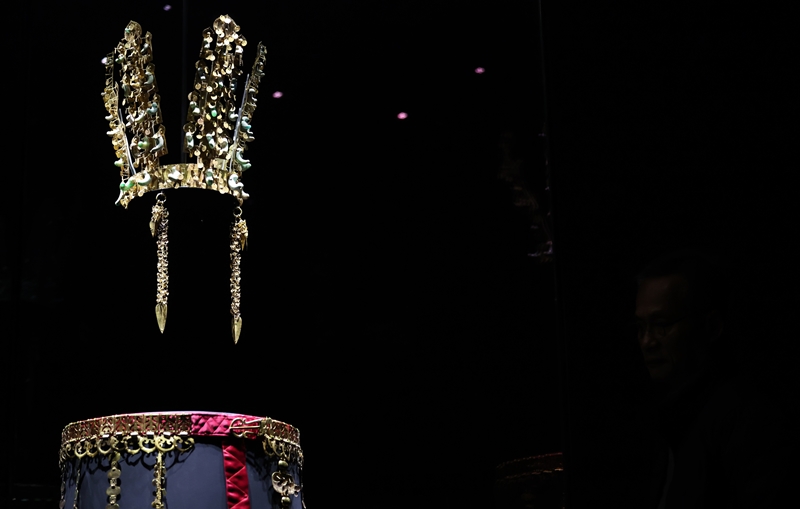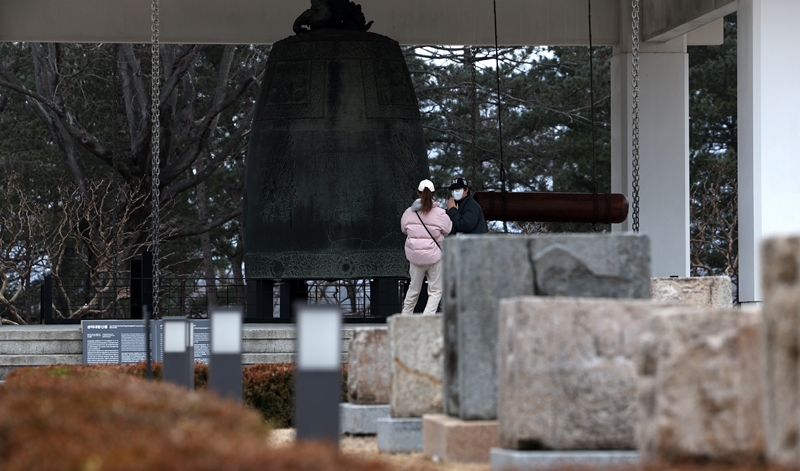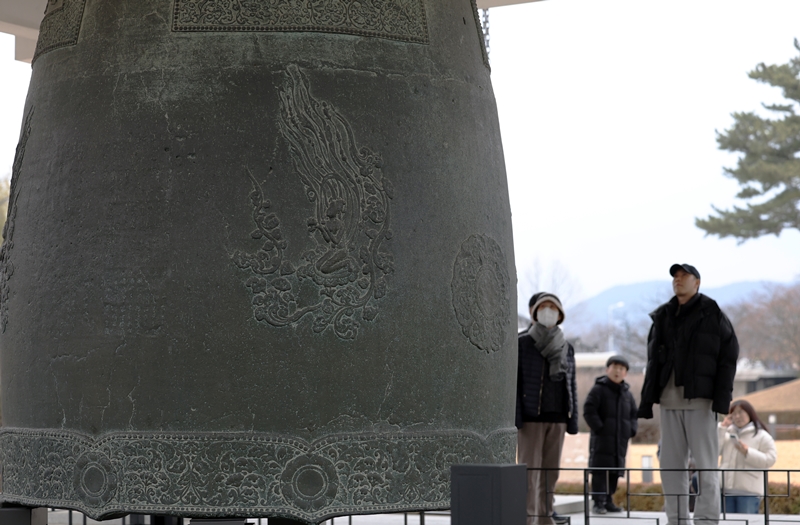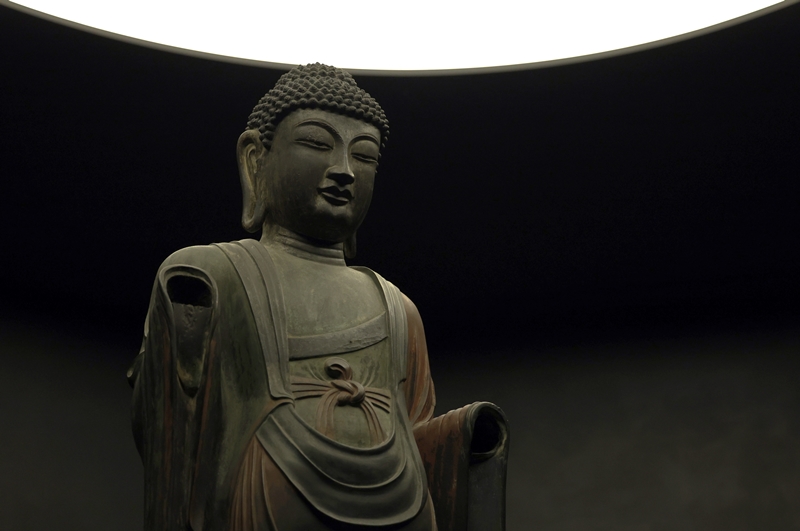By Lee Kyoung Mi
Photos = Lee Jun Young

The ancient Silla Kingdom began to center its framework on its maripgan (monarch), with gold jewelry meant only for the king, royal family and high-ranking aristocrats. To them, gold symbolized authority and the gold crown was reserved for only the highest authority.
A section at Silla History Gallery, the second exhibition hall of Gyeongju National Museum, in Gyeongju, Gyeongsangbuk-do Province, is especially popular with visitors. The section houses a gold crown from the ancient Silla Kingdom, and the relic's dazzling golden lights evokes oohs and ahs from afar.
The crown's decorations feature high-towering branches and deer antlers plus round moon stones and celadon-colored jade woven into a hanging gold thread. Moreover, long pendants hang on the left and right sides of the crown, as well as a belt that added even more extravagance to the crown wearer.
With Silla known as "the country of gold," everything about the crown is made of the precious metal.
Kim Daehwan, associate curator at the Gyeongju National Museum's Curatorial Affairs Office, said the most important thing to look for in the crown is the design. On the relic's tree branch designs, he said trees were "considered sacred entities in ancient times that connected heaven and Earth."
"Silla monarchs brought motifs from trees to flaunt the sacredness of their authority," Kim said, adding that the crown makes sounds when worn or moved as the moonstones and ornamental beads shake to symbolize the ruler's dignity.
Of the some 10 gold crowns excavated worldwide, six of them are from the Silla Kingdom. The most extravagant and advanced of the six is housed at the Gyeongju museum.
One of the best ways to see the crown is to imagine the Silla king and royal family wearing the fancy gold crown and everyone dressed in gold including earrings, necklaces, belts and even shoes to show off their power.

A prominent German scholar said the Sacred Bell of King Seongdeok, which was designated a National Treasure in 1962, alone could make a museum.
Pass the museum's front gate and enter the courtyard to see a large outdoor bell. The Sacred Bell of King Seongdeok is 366 cm tall, weighs 18.9 tons and was made by the finest Silla craftsmen.
King Gyeongdeok, Silla's 35th monarch, had the bell made for his father, King Seongdeok. Completed during the reign of Gyeongdeok's son and successor Hyegong, the relic is also known as the "Bell of Bongdeoksa Temple" and "Emile Bell."
At the loop on top of the bell is a dragon holding a yeouiju, or the wish-fulfilling jewel cintamani. Further down the body of the bell are bosang arabesque and lotus flower patterns, and below those is a beautiful bicheon, or a heavenly Buddhist being apsara, and the highlight of the bell.

The image of a bicheonsang (heavenly Buddhist being) is on the Sacred Bell of King Seongdeok. Legend has it that the body of a child was used to make the bell, but scientific analysis has disproved this notion, which might have been made up to reflect the difficulty of the relic's production.
In Korean Buddhism, a bicheon is a female hermit who flies across the sky and apparently ascends toward heaven while kneeling and earnestly praying for something.
Curator Lee Hyuntae said, "This image of a bicheon embodies the connection between heaven and Earth through the sounds of a bell."
Another highlight is the precise symmetry of the bell's left and right designs. Both sides each have a pair of reliefs depicting mythological women for a combined four on the bell.
"No bells this large have survived but this incomparable bell today can be used for design purposes," Lee said, calling the bell a "collection of Unified Silla's science and technology."
The bell's recorded sound can be heard every two 20 minutes on the hour. Visitors can ease their minds while listening to the soft and longlasting bell chimes and looking at the bicheon image.

This National Treasure-designated Medicine Buddha statue is believed to have been made around 800 A.D.
Yaksayeorae, or the Medicine Buddha, is widely known to heal the sick, extend human life and directly benefit people's lives. This is why the Medicine Buddha at Buddhist Sculpture Gallery 3 of the museum's Silla Art Gallery is so beloved.
This large sculpture is 180 cm tall and boasts striking craftsmanship but lacks hands. Based on its raised-arm posture and old photos, the Medicine Buddha is believed to have held an item in his left hand.
Curator Shin Myung-Hee recommended looking at the back of the statue, citing the large holes on the top of the head, head and back that were used to remove inner soil after the statue's creation. Because making such a large statue was difficult without advanced technology, the necessary elements of the process are visible on the back.
"If you visit the museum, please meet the Medicine Buddha and pray for your health and that of your family," she said.
# Tips to best enjoy Gyeongju National Museum
- Visit Cheonmachong Tomb, where the gold crown was unearthed. Visitors can look inside this royal tomb and see the restored excavation site. A walk from Gyeongju National Museum to Cheonmachong takes about 20 minutes, not that far but a bit tiring. Bus intervals are long so taking a taxi is recommended. Those fluent in Korean can hear a cabbie's jokes and the classic Gyeongsang-do accent while riding.- Going to the museum at night is also advised to see the illuminated bicheon image on the Sacred Bell of King Seongdeok; she looks as if it will pop out and fly. The museum has extended evening hours on the last Wednesday of every month and every Saturday from March to December from 10 a.m. to 9 p.m.
km137426@korea.kr
![[Must-sees at Korean museums] ④ Buyeo Nat'l Museum](/upload/content/image/49249826d45a4c1e9e5f2dbd370962cb_20240418151235.png)
![[Must-sees at Korean museums] ③ Gwangju Nat'l Museum](/upload/content/image/a930dfb35b144d6abdfb4483adcc7bf4_20240314090859.jpg)
![[Must-sees at Korean museums] ② Gyeongju Nat'l Museum](/upload/content/image/9a4d39e2842348aca36c10d73fb90f0a_20240216114311.jpg)
![[Must-sees at Korean museums] ① National Museum of Korea (II)](/upload/content/image/1c4dec52513347a98b9c43c9fd62551e_20240118131624.jpg)
![[Must-sees at Korean museums] ① National Museum of Korea (I)](/upload/content/image/a39a36cb636e4c02aae1ab053f63fe57_20240112112911.jpg)